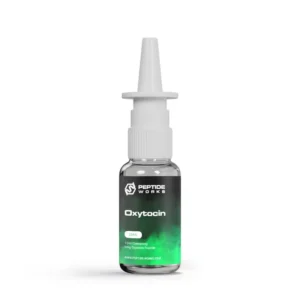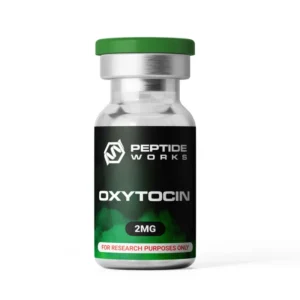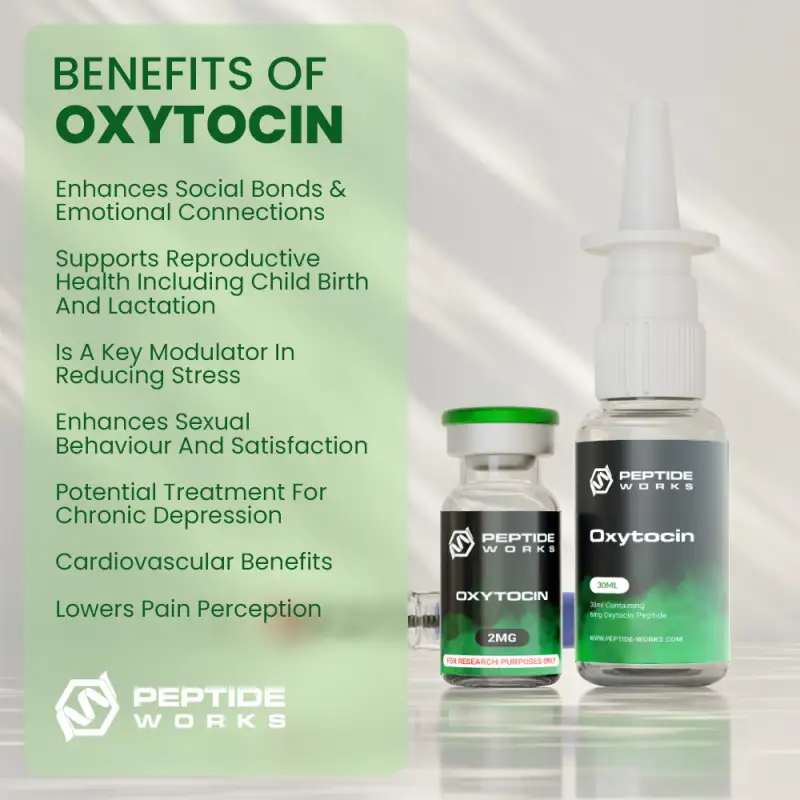PROMO!
First order? Get 10% OFF with this code: 1storder
Our Product Categories



Oxytocin is a nonapeptide hormone and neuropeptide made in the hypothalamus and released by the posterior pituitary. It is made up of nine amino acids and has a unique structure with a disulfide bridge, similar to vasopressin. Oxytocin serves two main roles: as a hormone that affects tissues in the body and as a neuromodulator in the brain.
Research suggests Oxytocin is an important hormone involved in reproductive functions like uterine contractions and lactation. Studies show it also plays a key role in promoting social bonds and trust. Additionally, oxytocin helps maintain balance in the body by influencing cardiovascular health, metabolism, and stress responses, making it vital for both physical and emotional well-being.
Peptide Sequence (IUPAC Condensed): H-Cys(1)-Tyr-Ile-Gln-Asn-Cys(1)-Pro-Leu-Gly-NH2
Molecular Formula: C43H66N12O12S2
Molecular Weight: 1007.2 g/mol
Synonyms: Love Hormone, OT, Otx

Research has shown that Oxytocin influences both the body and brain. It functions by attaching to the oxytocin receptor (OXTR), which is located in various areas, including the uterus, mammary glands, and parts of the brain related to social behavior. When oxytocin attaches to OXTR, it activates processes inside the cell, primarily involving calcium and protein kinase C, leading to various responses.
In tissues outside the brain, oxytocin helps control functions like smooth muscle contraction (for example, during labor and milk release) and cardiovascular balance. In the brain, oxytocin acts as a neuromodulator, influencing neurons to reduce fear, strengthen social connections, and manage emotions. Its effects, however, depend on where its receptors are located and the context in which it is activated.
Childbirth & breastfeeding functions:Oxytocin plays a vital role in childbirth and breastfeeding. During labor, it triggers uterine contractions via the Ferguson reflex, aiding cervical ripening and placental delivery. It also stimulates prostaglandin release, enhancing uterine contractility [1].
Studies show that postpartum, it promotes milk let-down by causing myoepithelial cell contraction in breast tissue. Additionally, oxytocin reduces maternal stress and fosters bonding with the infant. Synthetic oxytocin is widely used to induce or augment labor, ensuring safer deliveries [2].
Bonding, social connection & trust: Research suggests that Oxytocin plays a crucial role in bonding, social connection, and trust. It enhances parent–child bonding, romantic attachment, and prosocial behaviors by promoting recognition of social and emotional cues [3].
Oxytocin fosters calmness, reduces fear, and improves social interactions, contributing to well-being. Studies show it strengthens interpersonal bonds, facilitates social memory formation, and reduces anxiety [4].
Oxytocin nasal spray has been found to improve the detection and appraisal of social cues, particularly positive ones. Its dysfunction is linked to conditions like autism and social phobias, making it a potential therapeutic target for enhancing social and emotional health [5].
Stress/anxiety modulation & resilience: Research shows that Oxytocin plays a key role in stress modulation and resilience. It helps buffer stress responses by promoting calmness, reducing fear, and improving emotional outcomes after stressors. Oxytocin neurons are activated by stress, and its receptors, widely distributed in the brain, influence behavioral and neuroendocrine stress responses.
Studies have indicated that it supports allostasis by helping individuals adapt to changing environments and recover through active coping mechanisms [6]. Oxytocin also reduces blood pressure and fosters social interactions, further enhancing resilience. Clinical trials suggest therapeutic benefits for stress-related disorders, highlighting oxytocin’s potential to improve emotional well-being and support recovery from stress-induced challenges [3].
Cognitive and Social Neuroscience of Brain Changes: Research indicates that Oxytocin significantly influences brain regions associated with socio-emotional processing and decision-making. Meta-analyses of fMRI studies indicate that intranasal oxytocin (IN-OXT) enhances activity in regions such as the amygdala and left superior temporal gyrus during emotion processing tasks, underscoring its significance in social cognition [7].
Research indicates that oxytocin improves cognitive flexibility, enhances patience in delay-of-gratification tasks, and influences reward-related decision-making [8]. It additionally fosters prosocial behaviors, including generosity and the formation of social memory [9]. The findings indicate that oxytocin plays a domain-general role in facilitating adaptive, future-oriented behaviors, positioning it as a potential target for therapeutic interventions in conditions that impact social and cognitive functioning.
[1] M H Walter, H Abele, and C F Plappert (2021) The Role of Oxytocin and the Effect of Stress During Childbirth: Neurobiological Basics and Implications for Mother and Child – Frontiers in Endocrinology (Lausanne), 2021 Oct 27, Volume 12, Page 742236.
[2] K Uvnäs-Moberg (2024) The physiology and pharmacology of oxytocin in labor and in the peripartum period – American Journal of Obstetrics and Gynecology, Volume 230, Issue 3, Supplement, March 2024, Pages S740-S758.
[3] W W Ishak, M Kahloon, and H Fakhry (2011) Oxytocin role in enhancing well-being: a literature review – Journal of Affective Disorders, 2011 Apr, Volume 130 (Issues 1-2), Pages 1-9.
[4] F. Ramalheira and M. Conde Moreno (2022) Sharing is caring: a review on Oxytocin role in human behaviour and clinical implications – European Psychiatry, 2022, Volume 65 (Issue S1), Pages S735-S735.
[5] A J Guastella and C MacLeod (2012) A critical review of the influence of oxytocin nasal spray on social cognition in humans: evidence and future directions – Hormone Behavior, 2012 Mar, Volume 61 (Issue 3), Pages 410-8.
[6] Y Takayanagi and T Onaka (2021) Roles of Oxytocin in Stress Responses, Allostasis and Resilience – International Journal of Molecular Sciences, 2022, Volume 23 (Issue 1), Pages 150.
[7] S A Grace, S L Rossell, M Heinrichs, et al (2018) Oxytocin and brain activity in humans: A systematic review and coordinate-based meta-analysis of functional MRI studies – Psychoneuroendocrinology, 2018 Oct, Volume 96, Pages 6-24.
[8] G E Kapetaniou, M A Reinhard, P Christian, et al (2021) The role of oxytocin in delay of gratification and flexibility in non-social decision making – Elife, 2021 Apr 6, Volume 10, Page e61844.
[9] K Macdonald and T M Macdonald (2010) The peptide that binds: a systematic review of oxytocin and its prosocial effects in humans – Harvard Review of Psychiatry, 2010 Jan-Feb, Volume 18 (Issue 1), Pages 1-21.
The answers to the most frequently asked questions about Oxytocin.

Buy Oxytocin Peptide Nasal Spray from Peptide Works. Available in 15 ml and 30 ml glass spray bottles, this non-invasive administration route provides a convenient and effective way to ensure consistent application.
Oxytocin peptide may help promote calmness, trust, and social bonding. Research suggests it can reduce stress, support emotional balance and enhance positive social interactions. Some studies also link it to improved mood and relaxation. Scientists continue to study oxytocin’s potential benefits for emotional health and social behavior to understand its effects on well-being better.
Oxytocin has many roles beyond social bonding. It helps the body during childbirth and supports milk flow in breastfeeding. Research links it to stress relief, pain control, and emotional balance. Some studies suggest it also influences heart health and recovery. Scientists continue to explore how oxytocin affects physical processes and overall well-being.
Oxytocin peptide has gained attention for its possible role in improving social behavior. Studies suggest it may help ease social tension, increase eye contact, and improve understanding of social cues in autism spectrum conditions. However, research results are mixed, and its effects can vary. Scientists continue to study how oxytocin could support social communication and emotional awareness.
In the United States, the FDA classifies oxytocin as a prescription drug when used for medical purposes, such as childbirth. Oxytocin peptide, however, is not approved for human or veterinary use. It can be purchased legally for laboratory research and scientific study under the designation for research use only. Our oxytocin peptide is offered exclusively for research and development and is not intended for human consumption.

This blog explores the fascinating world of the “love hormone,” oxytocin, and its role in bonding, emotional balance, and stress regulation. It also looks at how oxytocin and related peptides, such as PT-141 and Kisspeptin, influence social behavior, reproduction, and stress response. The article highlights new research offering deeper insight into how these compounds shape human connection and overall health.

This blog explores the many roles of oxytocin in childbirth and postpartum recovery. It explains how this hormone helps with labor, prevents hemorrhage, and supports mother-baby bonding, stress relief, and breastfeeding, all of which are vital for maternal health. The article also looks at ongoing research on oxytocin supplements, highlighting their potential to improve recovery and safety for both mothers and infants.

This blog explores PT-141, a peptide being studied for its role in supporting desire and motivation in men over 40. It looks at how PT-141 acts in the brain, its link to dopamine pathways, and how it interacts with oxytocin. The article also highlights new research on how this peptide may help improve performance, strengthen bonding, and support overall men’s health.
ALL CONTENT AND PRODUCT INFORMATION AVAILABLE ON THIS WEBSITE IS FOR EDUCATIONAL PURPOSES ONLY.
DISCLAIMER: These products are intended solely as a research chemical only. This classification allows for their use only for research development and laboratory studies. The information available on our Peptide Works website: https://peptide-works.com/ is provided for educational purposes only. These products are not for human or animal use or consumption in any manner. Handling of these products should be limited to suitably qualified professionals. They are not to be classified as a drug, food, cosmetic, or medicinal product and must not be mislabelled or used as such.